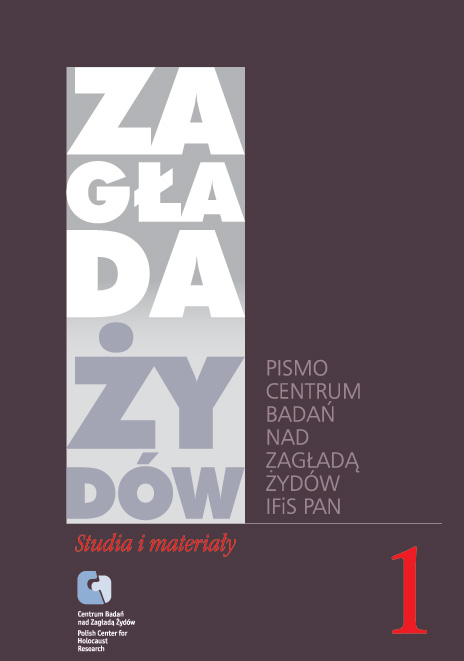Apokryfy z dziejów Żydowskiego Związku Wojskowego i ich autorzy.
Zagłada Żydów. Studia i Materiały, Nr 1 (2005), Strony: 165-190
Data zgłoszenia: 2020-10-07Data publikacji: 2005-12-01
 https://doi.org/10.32927/ZZSiM.153
https://doi.org/10.32927/ZZSiM.153
Abstrakt
This article is an attempt at a critical analysis of the history of the Jewish Fighting Union (JFU) and a presentation of their authors based on documents kept in the archives of the Institute of National Remembrance in Warsaw. The author believes that an uncritical approach and such a treatment of these materials, which were generated under the communist regime and used for political purposes resulted in a perverted and lasting picture of the history of this fighting organisation of Zionists-revisionists both in Poland and Israel. The author has focused on a deconsturction of the most important and best known “testimonies regarding the Warsaw Ghetto Uprising”, the development and JFU participation in this struggle, given by Henryk Iwaƒski, WΠadysΠaw Zajdler, Tadeusz Bednarczyk and Janusz Ketling–Szemley.
A comparative analysis of these materials, supplemented by important details of their war-time and postwar biographies, leaves no doubt as to the fact that they should not be analysed in terms of their historical credibility and leads one to conclude that a profound revision of research approach to JFU history is necessary.
Słowa kluczowe
Holokaust , powstanie w getcie warszawskim , Żydowski Związek Wojskowy , Korpus Bezpieczeństwa , krytyka źródeł
Licencja
Prawa autorskie (c) 2005 Autor&"Zagłada Żydów. Studia i Materiały"

Utwór dostępny jest na licencji Creative Commons Uznanie autorstwa 4.0 Międzynarodowe.
https://creativecommons.org/licenses/by/4.0
Czasopismo publikowane jest w standardzie Diamond Open Access na licencji CC-BY-4.0 Deed - Uznanie autorstwa 4.0 Międzynarodowa - Creative Commons
Inne teksty tego samego autora
- Dariusz Libionka, Głową w mur. Interwencje Kazimierza Papée, polskiego ambasadora przy Stolicy Apostolskiej, w sprawie zbrodni niemieckich w Polsce, listopad 1942 – styczeń 1943 , Zagłada Żydów. Studia i Materiały: Nr 2 (2006)
- Dariusz Libionka, W poszukiwaniu miliona Sprawiedliwych , Zagłada Żydów. Studia i Materiały: Nr 11 (2015)
- Dariusz Libionka, Największe zmartwienie „polskich patriotów” , Zagłada Żydów. Studia i Materiały: Nr 5 (2009)
- Dariusz Libionka, Against a Brick Wall. Interventions of Kazimierz Papee, the Polish Ambassador at the Holy See with Regard to German Crimes in Poland, November 1942–January 1943 , Zagłada Żydów. Studia i Materiały: 2008: Holocaust Studies and Materials
- Anka Grupińska, Dariusz Libionka, Rozmowa z Józefem Grynblattem, członkiem Betaru i Żydowskiego Związku Wojskowego w czasie powstania w getcie warszawskim , Zagłada Żydów. Studia i Materiały: Nr 3 (2007)
- Dariusz Libionka, Pierwszy zarys historii Żydowskiej Organizacji Bojowej [Icchak Cukierman, Powstanie i rozwój ŻOB] , Zagłada Żydów. Studia i Materiały: Nr 9 (2013)
- Adam Kopciowski, Dariusz Libionka, Zapiski członka Komendy Żydowskiej Organizacji Bojowej Hersza Berlińskiego , Zagłada Żydów. Studia i Materiały: Nr 19 (2023)
- Dariusz Libionka, Z getta warszawskiego przez Francję i Hiszpanię do Londynu. Niewiarygodna historia Edwarda Rajnfelda-Tohariego , Zagłada Żydów. Studia i Materiały: Nr 18 (2022)
- Dariusz Libionka, Narodowa Organizacja Wojskowa i Narodowe Siły Zbrojne wobec Żydów pod Kraśnikiem – korekta obrazu , Zagłada Żydów. Studia i Materiały: Nr 7 (2011)
- Dariusz Libionka, Uwagi o ratowaniu Żydów w „okolicach Treblinki” [recenzja: Edward Kopówka, ks. Paweł Rytel-Andrianik, Dam im imię na wieki. Polacy z okolic Treblinki ratujący Żydów] , Zagłada Żydów. Studia i Materiały: Nr 9 (2013)
Podobne artykuły
- Sharon Geva, Bojowniczki podziemia, matki i córki. Żydowskie kobiety w getcie warszawskim podczas powstania (kwiecień–maj 1943) , Zagłada Żydów. Studia i Materiały: Nr 19 (2023)
- Anka Grupińska, Dariusz Libionka, Rozmowa z Józefem Grynblattem, członkiem Betaru i Żydowskiego Związku Wojskowego w czasie powstania w getcie warszawskim , Zagłada Żydów. Studia i Materiały: Nr 3 (2007)
- Jacek Leociak, Rocznice powstania w getcie warszawskim w dyskursie publicznym (ze szczególnym uwzględnieniem lat 1943–1944, 1968, 2023) , Zagłada Żydów. Studia i Materiały: Nr 19 (2023)
- Dariusz Libionka, Apocrypha from the History of the Jewish Military Union and its Authors , Zagłada Żydów. Studia i Materiały: 2008: Holocaust Studies and Materials
- Havi Dreifuss, Komenda Żydowskiej Organizacji Bojowej podczas powstania w getcie warszawskim – nowe ujęcie , Zagłada Żydów. Studia i Materiały: Nr 19 (2023)
- Dariusz Libionka, Walka i propaganda. Powstanie w getcie warszawskim z perspektywy polskiego Londynu , Zagłada Żydów. Studia i Materiały: Nr 10 (2014)
- Marta Janczewska, Badania nad głodem w getcie warszawskim – problemy etyczne , Zagłada Żydów. Studia i Materiały: Nr 5 (2009)
- Adam Kopciowski, Dariusz Libionka, Relacja działaczki Poalej Syjon-Lewicy Poli Elster o sytuacji na Umschlagplatzu i w transporcie do Poniatowej w kwietniu 1943 r , Zagłada Żydów. Studia i Materiały: Nr 19 (2023)
- Maria Ferenc, „Gdzież źródło błogosławione, z którego czerpał on swą moc…” Pamięć o Mordechaju Anielewiczu w Polsce w latach 1943–1949 , Zagłada Żydów. Studia i Materiały: Nr 18 (2022)
- Lior Inbar, Zawsze byliśmy donkiszotami. Kibuc im. Bojowników Gett w Izraelu , Zagłada Żydów. Studia i Materiały: Nr 19 (2023)
1 2 3 4 5 6 7 8 9 10 11 12 13 14 15 16 17 18 19 20 21 22 23 24 25 26 27 28 29 30 31 32 33 > >>
Możesz również Rozpocznij zaawansowane wyszukiwanie podobieństw dla tego artykułu.
 English
English
 Język Polski
Język Polski



 https://orcid.org/0000-0003-0180-6463
https://orcid.org/0000-0003-0180-6463

